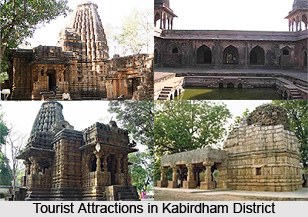 History of Kabirdham District narrates the course of events that led to the formation of this district. Kabirdham district, previously known as Kawardha district, formed on 6th of July 1998 by the Government of Madhya Pradesh. It comprised of the excluded Tehsil Kawardha of Rajnandgaon district and Tehsil Pandariya of Bilaspur district. Located at the southern bank of Sakri River, Kabirdham district is a beautiful place. The district derived its name from Kabir Sahib, who arrived this region in the past. Seats of the descendents of his disciple named Dharmadas were also established in the district. It was the centre of Kabir Panthis before Damakhera, Raipur district.
History of Kabirdham District narrates the course of events that led to the formation of this district. Kabirdham district, previously known as Kawardha district, formed on 6th of July 1998 by the Government of Madhya Pradesh. It comprised of the excluded Tehsil Kawardha of Rajnandgaon district and Tehsil Pandariya of Bilaspur district. Located at the southern bank of Sakri River, Kabirdham district is a beautiful place. The district derived its name from Kabir Sahib, who arrived this region in the past. Seats of the descendents of his disciple named Dharmadas were also established in the district. It was the centre of Kabir Panthis before Damakhera, Raipur district.
Till early 18th century, Tehsil Kabirdham which is a part of Kabirdham district was known to be the state Kawardha. It was established as tehsil Kawardha in the period of 1895 to 1902 in Mandla district and during 1903 to 1911, in Bilaspur district. From 1912 to 1948, it served as a part of Raipur district and in 1948 in became included in Durg district. Till 25th January 1973, it remained included in Durg. From 26th January 1973, the tehsil merged with Rajnandgaon till 5th July 1998. Similarly tehsil Pandariya, was previously known as Pandariya Zamindari and was included in the district before 1952. Since 1952, Pandariya served as the community block Head-Quarters of Bilaspur district. In the year 1986, it was promoted to the status of tehsil and till 5th July 1998, remained merged with Bilaspur district.
Both these tehsils, Kabirdham and Pandariya have immense historical significance. Kabirdham served as the capital Nagvanshi kings between the period of 9th to 14th century. It was later captured by Haihayvanshi kings who were associated with state Ratanpur. Archaeological ruins of a temple and a fort were built by these kings are still found in this region.
This article is a stub. You can enrich by adding more information to it. Send your Write Up to content@indianetzone.com



















